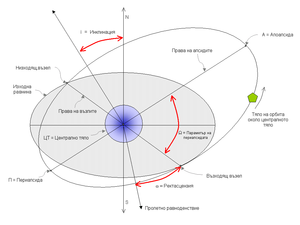Orbital elements
|
|
The elements of an orbit are the parameters needed to specify that orbit uniquely, given a model of two ideal masses obeying the Newtonian laws of motion and the inverse-square law of gravitational attraction. Because there are multiple ways of defining a motion, depending on which set of variable you choose to measure, there are several different ways of defining sets of orbital elements, each of which will define the same orbit.
There are seven degrees of freedom in this model (time, position in 3-space at that time, velocity in 3-space at that time) so all sets of orbital elements have seven parameters. (See also: orbital state vectors).
| Contents |
Keplerian elements
The traditionally used set of orbital elements is called the set of Keplerian elements, after Johannes Kepler and his Kepler's laws. The Keplerian elements are:
- Epoch (time)
- Inclination (<math>i\,\!<math>)
- Longitude of the ascending node (☊)
- Argument of periapsis (<math>\omega\,\!<math>)
- Eccentricity (<math>e\,\!<math>)
- Orbital period (<math>T\,\!<math>)
- Mean longitude (Mean anomaly (<math>M\,\!<math>) at epoch)
Keplerian elements can be obtained from orbital state vectors using VEC2TLE software or by some direct computations.
Orbit.png
Other orbital parameters, such as the semi-major axis, can then be calculated from the Keplerian elements. In many cases, the semi-major axis is used as an orbital element instead of period. The elements can be seen as defining the orbit by degrees:
- The semi-major axis (or the period, interchangeably) fixes the size of the orbit.
- The eccentricity fixes its shape.
- The inclination (orange in Fig. 2) and longitude of the ascending node (green) fix its plane.
- The argument of perihelion (blue) orients the orbit within its plane.
- The epoch (or mean anomaly, interchangeably) (red) fixes the object in time on its orbit.
Because the simple Newtonian model of orbital motion of idealized points in free space is not exact, the orbital elements of real objects tend to change over time. For artificial satellites grazing the fringes of the atmosphere, an eighth parameter (" drag") may be added. For the planets and moons it is more usual simply to add a time term to the elements.
Two line elements
Keplerian elements parameters can be encoded as text in a number of formats. The most common of them is the NASA/NORAD "two-line elements" (TLE) format, originally designed for use with 80-column punched cards, but still in use because it is the most common format, and works as well as any other.
Reference:
- Explanatory Supplement to the Astronomical Almanac. 1992. K. P. Seidelmann, Ed., University Science Books, Mill Valley, California.
See also
External links
- Keplerian Elements tutorial (http://www.amsat.org/amsat/keps/kepmodel.html)
- another tutorial (http://marine.rutgers.edu/mrs/education/class/paul/orbits.html)
- Spacetrack Report No. 3 (http://www.amsat.org/amsat/ftp/docs/spacetrk.pdf), a really serious treatment of orbital elements from NORAD (in pdf format)
- Celestrak Two-Line Elements FAQ (http://celestrak.com/columns/v04n03/)

